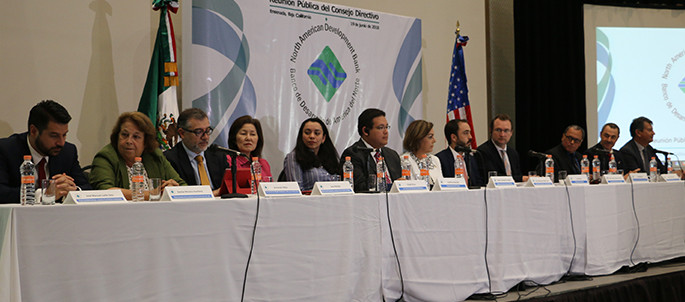Three new water and wastewater projects approved for border communities

Ensenada, Baja California– The Board of Directors of the North American Development Bank (NADB) approved the certification and financing of three new water and wastewater projects that altogether represent a total investment of almost US$4.40 million. NADB will provide grants totaling more than $3.28 million to help finance their implementation.
These three projects will benefit nearly 10,000 people by eliminating 0.5 million gallons a day of untreated wastewater discharges and improve water service to 490 households.
“The approval of these projects reaffirms the continuity of essential programs and functions following the November 2017 Charter amendments, which streamlined the organizational structure of the Bank to encourage efficiency in its efforts to help preserve and protect the border environment,” stated NADB Managing Director Alex Hinojosa. “Today was the first meeting of the Board of Directors under NADB’s new institutional framework, which included a strategic planning session to discuss the Bank’s vision and actions for the next five years.”
The projects approved include improvements to the wastewater collection and treatment system in Camargo, a community located northeast of Reynosa in Tamaulipas. The project consists of replacing a sewer main, lift station and force main; upgrading the wastewater treatment plant to increase its capacity to 0.57 million gallons a day and improve the quality of the effluent produced; and incorporating a methane capture system that will reduce harmful emissions generated by the plant. The project also includes the construction of wastewater collection infrastructure that will provide first-time sewer service to 347 households in the Misión y El Sauz subdivisions.
The local water utility, Comisión Municipal de Agua Potable y Alcantarillado de Camargo (COMAPA), will receive a US$2.53 million grant from NADB’s Border Environment Infrastructure Fund (BEIF), which is funded by the U.S. Environmental Protection Agency (EPA), as well as additional funding from the Mexican National Water Commission (CONAGUA) and the Tamaulipas State Water Commission.
The second project will provide a safe and reliable water system for the rural community of José Silva Sánchez in the municipality of Soto la Marina, Tamaulipas. The main components of the project consist of installing a new transmission line, elevated storage tank and distribution system, as well as new equipment for the existing well, including a chlorination unit. The local water utility, Comisión Municipal de Agua Potable y Alcantarillado de Soto la Marina (COMAPA), will receive a US$250,000 grant from NADB through its Community Assistance Program (CAP).
The third project, to be implemented in the community of Whetstone, Arizona, will improve the water supply and distribution system for 459 households by building a third well and installing a water main to connect the new well to the distribution system, along with electrical upgrades to the two existing wells, which will serve as a backup water supply. Whetstone Water Improvement District (WWID) will receive a US$500,000 CAP grant from NADB to implement the project.
NADB Chief Environmental Officer Salvador Lopez noted that these projects will ensure treatment of 100% of the wastewater flows collected in Camargo, provide first-time drinking water service to the 135 residents of José Silva Sánchez, Tamaulipas, and guarantee adequate water supply to prevent service interruptions and low-pressure problems in the community of Whetstone, Arizona.
NADB also announced that it had recently formalized its advisory role in a Mexican Capital Development Certificate (CKD) mechanism and that it will soon be issuing its first green bond. NADB Deputy Manager Director Calixto Mateos stated that “NADB will assist the CKD with origination of projects, leveraging its experience in underwriting and financing infrastructure.” He also added “the green bond issue is a natural step forward under the amended charter, which is a perfect match for the green bond framework.”